Digital exhibition guide
At once elegiac as it is urgent, Listening All Night To The Rain by John Akomfrah unfolds as a monumental, multi-screen filmic installation that weaves together questions of ecology, empire, and migration through a layered sonic lens. First commissioned for the British Pavilion at La Biennale di Venezia in 2024, the work is reimagined here in the Museo Nacional Thyssen-Bornemisza for TBA21 Thyssen-Bornemisza Art Contemporary.
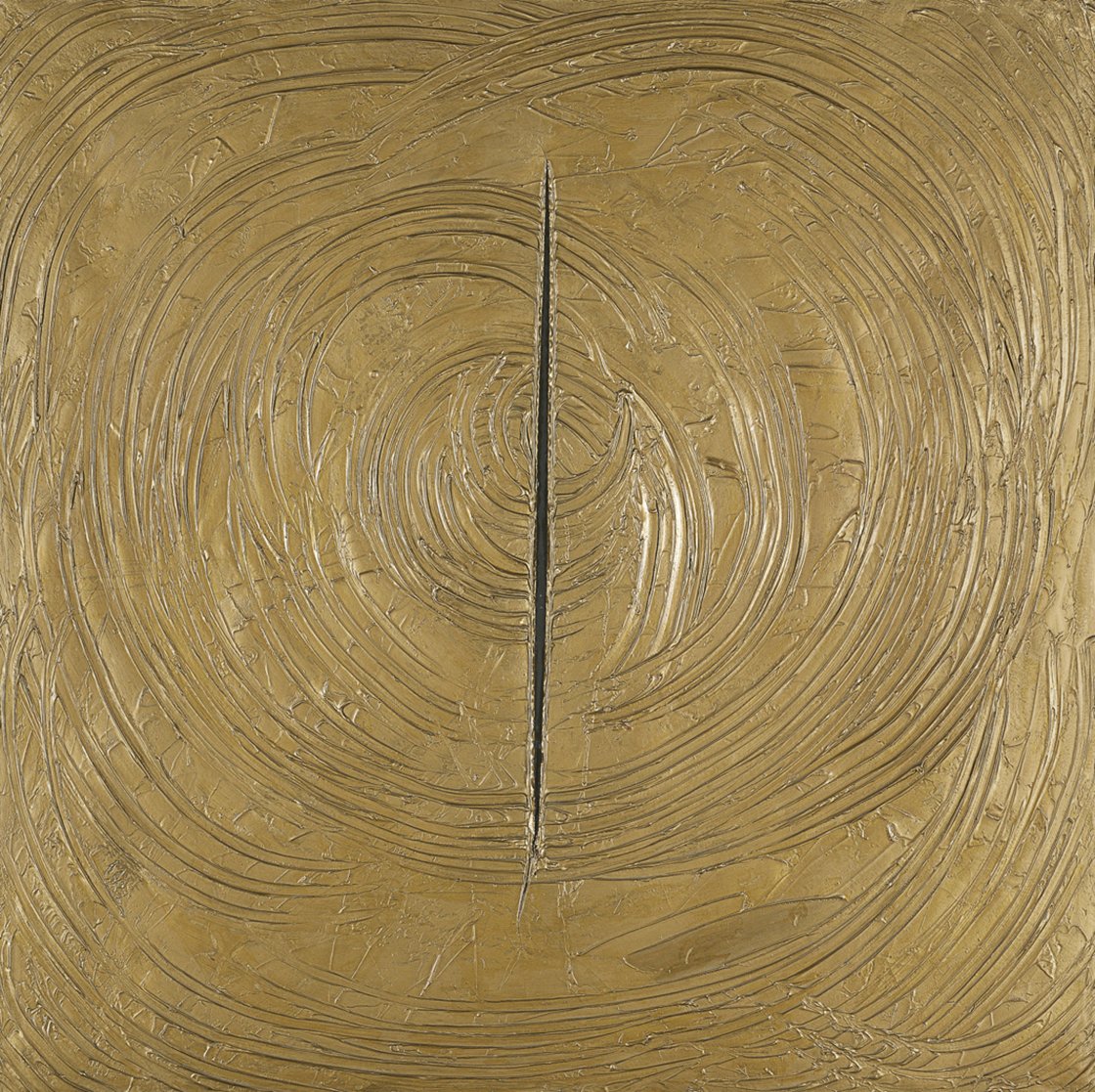
British artist John Akomfrah’s (b. 1957. Accra, Ghana) monumental commission, entitled Listening All Night To The Rain,was first commissioned for the British Pavilion at La Biennale di Venezia in 2024 and continues his abiding interest in post-colonialism, ecology and the politics of aesthetics with a renewed focus on the sonic. Drawing its title from Chinese writer and artist Su Dongpo’s (1037 – 1101) poetry that meditates upon the transitory nature of life during a period of political exile, the exhibition is seen as a manifesto that encourages the act of listening as a form of activism. In five overlapping multimedia and audio installations arranged into ‘cantos’ or movements and reimagined for Museo Nacional Thyssen-Bornemisza’s galleries, Akomfrah positions various theories of ‘acoustemology’: a portmanteau combining ‘acoustic’ and ‘epistemology’ coined by ethnomusicologist Steven Feld that denotes how the sonic experience mirrors and shapes our world.
The exhibition weaves together newly filmed material with found still images, video footage, audio clips and texts from hundreds of international archive collections and libraries. Akomfrah juxtaposes these documented geopolitical narratives with imagined tableaux – often surreal or dreamlike in nature – in order to reposition the role of art in its ability to write history in unexpected ways, forming critical and poetic connections between different geographies and time periods. Through methods of bricolage (the reuse of diverse materials in order to produce new meanings), non-linearity and repetition, the artist tells stories from the five continents through the ‘memories’ of multiple filmed characters who represent the migrant community in Britain.
Evoking a sense of contemplation and reverie, Listening All Night To The Rain houses a series of sculptural installations with embedded screens that are inspired by the structure and form of altarpieces from religious architectures. Each gallery space layers a specific colour field influenced by the paintings of American artist Mark Rothko (1903 – 1970) in order to point to the ways in which abstraction can represent the fundamental nature of human drama.
Canto I opens on the exterior of the museum’s building, framing voices and imagery from the Global South as a meditation on empire, migration and the sonic traces of climate colonialism. Inside, the exhibition opens with a presentation of historic artwork drawn from the Museo Nacional Thyssen-Bornemisza’s collection, tracing formal and conceptual threads that connect to Akomfrah’s practice. The selection reflects his sustained engagement with art history as both language and lineage - an archive through which he examines modernity and its role as a witness to history. Gestures of abstraction, rhythm and rupture that animate twentieth-century painting and sculpture find renewed resonance in Akomfrah’s cinematic grammar, where modernism’s aesthetic experiments are recast through postcolonial thought. For Akomfrah, art history is an active terrain - one he revisits to expose its omissions, expand its possibilities and imagine new genealogies of resistance and repair.
Tarini Malik, Curator of the exhibition.
John Akomfrah
John Akomfrah is a hugely respected artist and filmmaker, whose works are characterised by their investigations into memory, post-colonialism, temporality and aesthetics and often explore the experiences of migrant diasporas globally.
Akomfrah was a founding member of the influential Black Audio Film Collective, which started in London in 1982 alongside artists David Lawson and Lina Gopaul, who he still collaborates with today alongside Ashitey Akomfrah as Smoking Dogs Films. Their first film, Handsworth Songs (1986) explored events surrounding the 1985 riots in Birmingham and London through a charged combination of archive footage, still photos, newly shot material and newsreel. The film won several international prizes and established a multi-layered visual style that has become a recognisable motif of Akomfrah’s practice.
Other works include the three-screen installation The Unfinished Conversation (2012), a moving portrait of the cultural theorist Stuart Hall’s life and work; Peripeteia (2012), an imagined drama visualising the lives of individuals included in two 16th century portraits by Albrecht Dürer and Mnemosyne (2010) which exposes experiences of migrants in the UK, questioning the notion of Britain as a promised land by revealing the realities of economic hardship and casual racism.
In 2015, Akomfrah premiered his three-screen film installation Vertigo Sea (2015), which explores what Ralph Waldo Emerson calls ‘the sublime seas’. Fusing archival material, readings from classical sources and newly shot footage, Vertigo Seahighlights the cruelty of the whaling industry and juxtaposes it with scenes of many generations of migrants making epic crossings of the ocean for a better life. In 2017, Akomfrah presented Purple (2017), which addresses climate change, human communities and wilderness; and Precarity (2017), following the life of forgotten New Orleans jazz trumpeter Charles ‘Buddy’ Bolden.

In 2018, Akomfrah participated in the UK wide World War One arts programme 14-18 Now, with his multiscreen installation Mimesis: African Soldier (2018), which commemorated African and colonial participants who fought, served and perished during The Great War. In 2019 Akomfrah presented Four Nocturnes (2019) in the Ghana Pavilion at the 58th Venice Biennale, a three-channel piece reflecting on the intertwined relationship between humanity’s destruction of the natural world and our of ourselves.
In 2023, he premiered two major five channel films at the 15th Sharjah Biennial: Arcadia (2023), reflecting on ‘The Columbian Exchange’ between the Americas, Afro-Eurasia and Europe from the 1400s onwards; and Becoming Wind (2023), an allegorical representation of the Garden of Eden and its disappearance.
In 2024 Akomfrah presented a new body of work entitled Listening All Night to the Rain in the British Pavilion in Venice, commissioned by the British Council for the 60th International Art Exhibition – La Biennale di Venezia.
Akomfrah was awarded the Artes Mundi Prize in 2017 and a Knighthood for services to the Arts in the 2023 New Year Honours.
Recent solo exhibitions: National Museum of Cardiff, Wales (2025); Glasgow Museum of Art, Scotland (2024); Wrightwood 659. Chicago, USA (2024); British Pavilion, 60th International Art Exhibition – La Biennale di Venezia, Italy (2024); The Box, Plymouth, UK (2023); Schirn Kunsthalle Frankfurt, Germany (2023); Smithsonian National Museum of African Art (2023) and Hirshhorn Museum and Sculpture Garden, Washington D.C., USA (2022); Remai Modern, Saskatoon, Canada (2022); Towner Eastbourne, UK (2021); Fundació Antoni Tàpies, Barcelona, Spain (2021); Centro Andaluz de Arte Contemporáneo, Sevilla, Spain (2020); Seattle Art Museum, WA, USA (2020); Secession, Vienna, Austria (2020); BALTIC, Gateshead, UK (2019); ICA Boston, MA, USA (2019); Museu Coleção Berardo, Lisbon, Portugal (2018); New Museum, New York, NY, USA (2018); Bildmuseet, Umeå University, Umeå, Sweden (2015, 2018); SFMOMA, San Francisco, CA, USA (2018); Museo Nacional Thyssen-Bornemisza, Madrid, Spain (2018); Barbican, London, UK (2017). Recent international group exhibitions include ‘Ocean’, Louisiana Museum of Modern Art, Denmark (2024); ‘Entangles pasts, 1768-now’, Royal Academy, London, UK (2024); ‘Sharjah Biennial 15: Thinking Historically in the Present’, Sharjah, United Arab Emirates (2023); ‘Global Ghana’, The Africa Institute, Sharjah, UAE and Accra, Ghana (2022); ‘Fault Lines’, North Carolina Museum of Art, Raleigh, USA (2022); ‘Posteriority’, Museum of Contemporary Art Busan, South Korea (2021); ‘Family – Visions of a shared humanity’, Art Gallery of New South Wales, Sydney, Australia (2021); ‘Am I Human To You?’, Art Museum KUBE, Alesund, Norway (2021); ‘Affect Machine: Self-healing in the Post-Capitalist Era’, Taipei Fine Arts Museum, Taiwan (2021); ‘Terminal’, City Gallery, Wellington, New Zealand (2020); Ghana Pavilion, 58th Venice Biennale, Venice, Italy (2019); ‘Strange Days: Memories of the Future’, New Museum x The Store, London, UK (2018); ‘Histórias Afro-Atlânticas’, Museu de Arte de São Paulo Assis Chateaubriand, São Paulo, Brazil (2018); ‘From where I stand, my eye will send a light to you in the North’, Te Tuhi Museum, Auckland, New Zealand (2018); Prospect 4, New Orleans, LA, USA (2017); ‘Restless Earth’, La Triennale di Milano, Milan, Italy (2017); ‘Unfinished Conversations’, Museum of Modern Art, New York City, NY, USA (2017); ‘British Art Show 8’ (2015-17); ‘All the World’s Futures’, 56th Venice Biennale, Venice, Italy (2015); ‘Africa Now: Politcal Patterns’, SeMA, Seoul, South Korea (2014); Sharjah Biennial 11, Sharjah, United Arab Emirates (2013); Liverpool Biennial, UK (2012) and Taipei Biennial, Taiwan (2012).
Tarini Malik
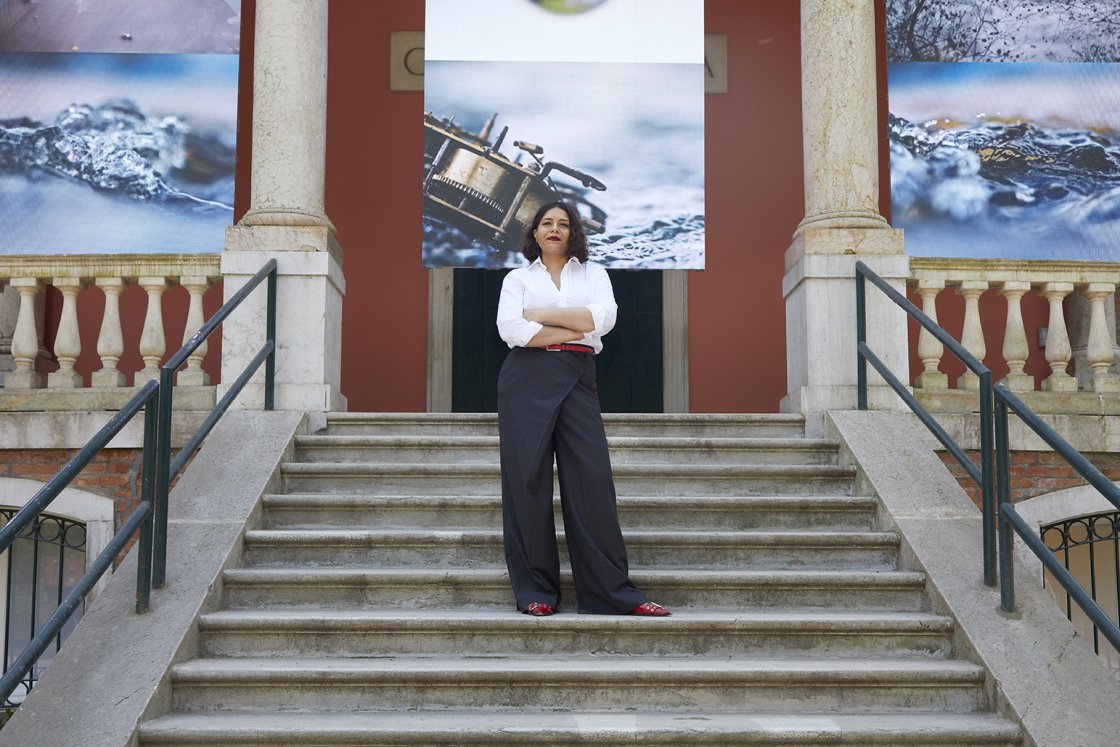
Tarini Malik is currently Curator of Modern and Contemporary Art at the Royal Academy of Arts. She was the Shane Ackroyd Associate Curator of the British Pavilion at the 2024 edition of Venice Biennale working with artist John Akomfrah.
Previously, she was a curator at the Whitechapel Gallery where she was responsible for the planning of artistic programmes, and at the Hayward Gallery where she organised a series of landmark group exhibitions, as well as the first solo presentations in the UK of several international artists whose practices deal with themes of post-colonialism and identity politics.
From 2013-2017, Malik was Head of Exhibitions for artist Isaac Julien and Research Curator with Mark Nash on several major touring international exhibitions.
In 2015, she was Research Curator for the main exhibition at the Venice Biennale curated by Okwui Enwezor, entitled “All The Worlds Futures”. Malik has also held curatorial posts at Fiorucci Art Trust, Frieze Projects and Serpentine Galleries. She has published her writing in various magazines and journals and lectured widely on cultural studies and curating.
Cantos
In five overlapping multimedia and audio installations arranged into ‘cantos’ or movements and reimagined for Museo Nacional Thyssen-Bornemisza’s galleries, Akomfrah positions various theories of ‘acoustemology’: a portmanteau combining ‘acoustic’ and ‘epistemology’ coined by ethnomusicologist Steven Feld that denotes how the sonic experience mirrors and shapes our world.
Canto I opens British-Ghanaian artist John Akomfrah’s Listening All Night to the Rain, first presented at the British Pavilion at La Biennale di Venezia in 2024. This series of interlocking video and sound installations explores the structural forces behind climate colonialism and forced migration, and how they register sonically. Framed as an intervention with the museum’s neoclassical architecture, Canto I foregrounds imagery and voices from the Global South, honouring those marginalised by the legacies of imperialism
Akomfrah’s signature filmic style of montage combines newly filmed material with archival photographs, footage, sound and text. Appearing as mist, rain, floods and open seas, water is a central motif of the artwork and forms the connective tissue that holds the many visual and sonic narratives together. Like sound, it moves in waves, echoing the dispersal of diaspora communities across geographies, and the fluctuations of time. Canto I introduces the exhibition’s key themes, interweaving images of empire, protest, migration and racial injustice into a layered meditation on memory and resistance.
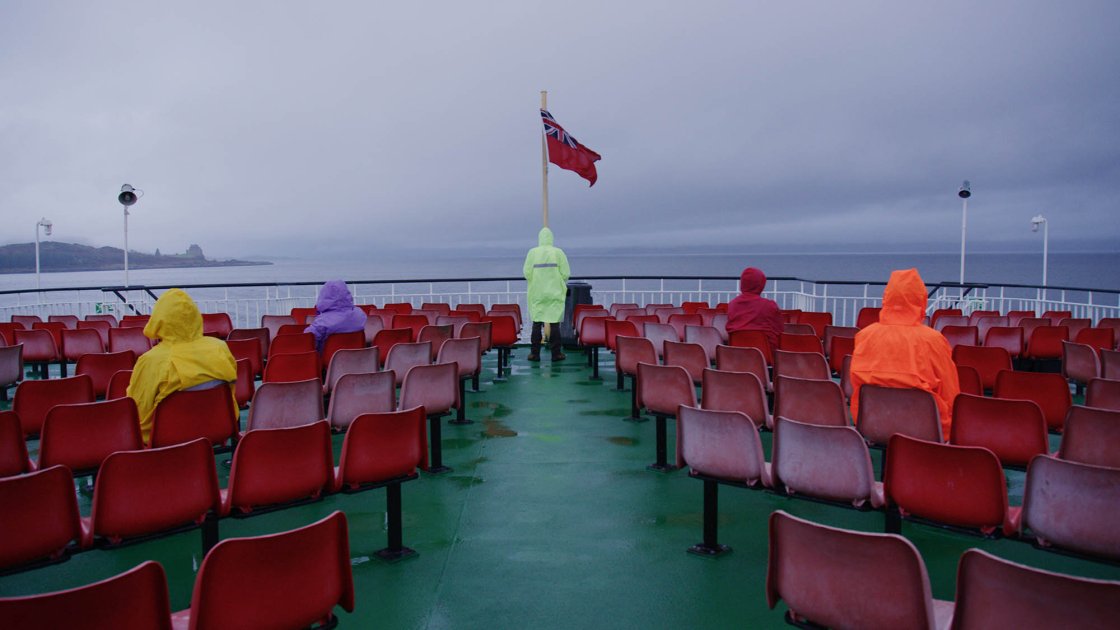

In Canto IV, various figures appear on a coastal shoreline, surrounded by the remnants of past lives: fruits, vegetables, butterfly specimens, rubber ducks and defunct listening devices. Beneath the water, shoals of fish scatter amidst the sound of sea shanties and shipbuilding, evoking histories of exploration, labour and displacement. Archival images of ancestors are interspersed with contemporary characters: a young Inuit woman contemplates her place in a disenfranchised world, while a dockworker surveys a coastline transformed by industry, overfishing and the long shadow of empire. Exploring listening as a way of knowing and connecting across human and non-human worlds, Akomfrah’s work collapses fixed notions of time and place by layering visual and sonic histories from diverse origins and styles.
Canto VII reflects Akomfrah’s commitment to addressing pivotal moments in British history through a critical lens. Reframing narratives of mass migration, archival imagery revisits the Windrush generation; named for those who arrived from the Caribbean on the HMT Empire Windrush in 1948. Depicting the everyday lives of women and children, the work also highlights the racism and hardship migrants faced during Britain’s post-industrial decline from the late 1960s onward. Filmed across Yorkshire and Scotland, these landscapes become imagined homelands for characters whose memories unfold on screen. The Canto concludes with fragments from speeches by Martin Luther King Jr, Malcolm X, Angela Davis and others, connecting the black British experience to global movements for justice.

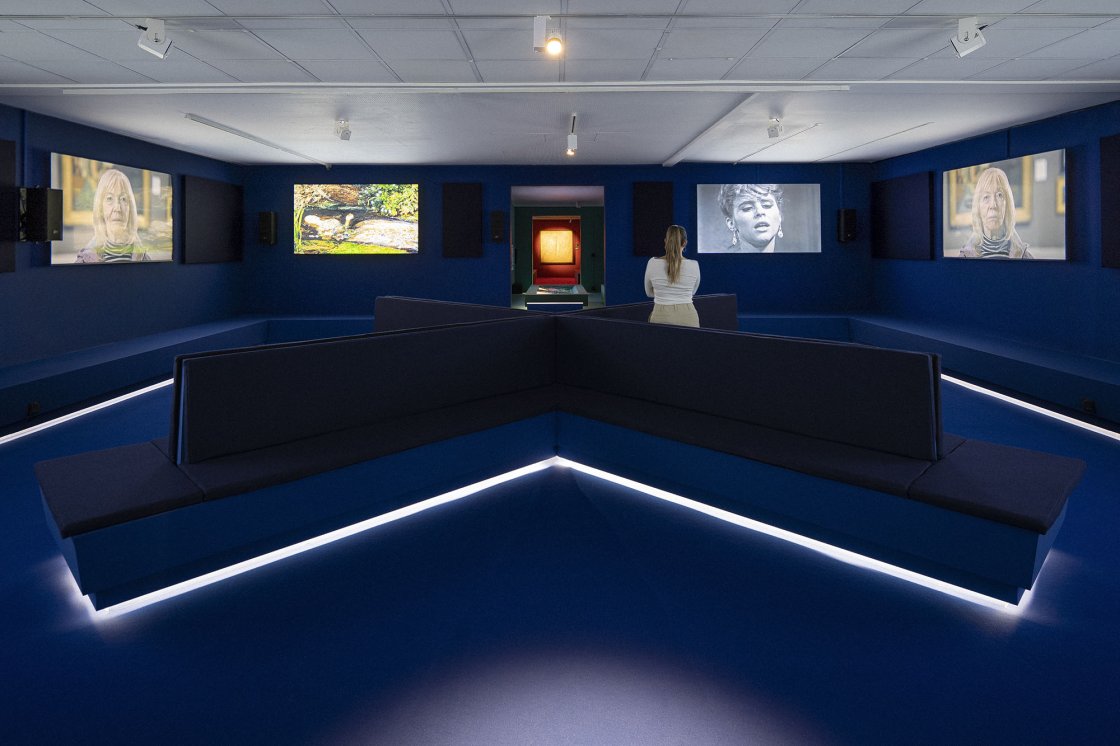
Canto VI traces pivotal moments in the histories of colonised nations, focusing on the independence movements and uprisings that swept Africa and Asia from the 1940s to the 1970s. Archival footage reflects on the Mau Mau rebellion in Kenya (1952–1960) and the brutality of Britain’s counter-insurgency campaign. In the Congo, it follows the struggle for independence from Belgian colonialism, highlighting Patrice Lumumba and the challenges of post-colonial nation-building. Nigeria’s path to independence and the 1970 civil war reveals the tragic consequences of colonial amalgamation, while the Partition of India in 1947 is seen through emblematic figures such as Jawaharlal Nehru. Akomfrah frames these histories through the diasporic experience in Britain, connecting personal memory to the wider, enduring legacies of colonialism.
Underscoring the interconnectedness between military conflicts and ecological devastation - from ecocide to ecoterrorism – in Canto VIII, the artist reveals inalterable? impacts on the environment. In the context of the Korean War (1950-53), Akomfrah highlights the devastating impact of the conflict, particularly the extensive bombing campaigns by the US that led to widespread destruction through pesticides like dichlorodiphenyltrichloroethane (DDT) in mass quantities. Footage from the Vietnam War (1955-75) emphasises how the war not only caused severe damage to human life, but also to the land. Surreal and dreamlike tableaux also recur throughout: a camera tracks over horizontal bodies in states of rest or death, framed by eclectic displays of anachronistic objects and a soundscape of echoes and reverberations, including recordings of environmentalists warning of ecological devastation.
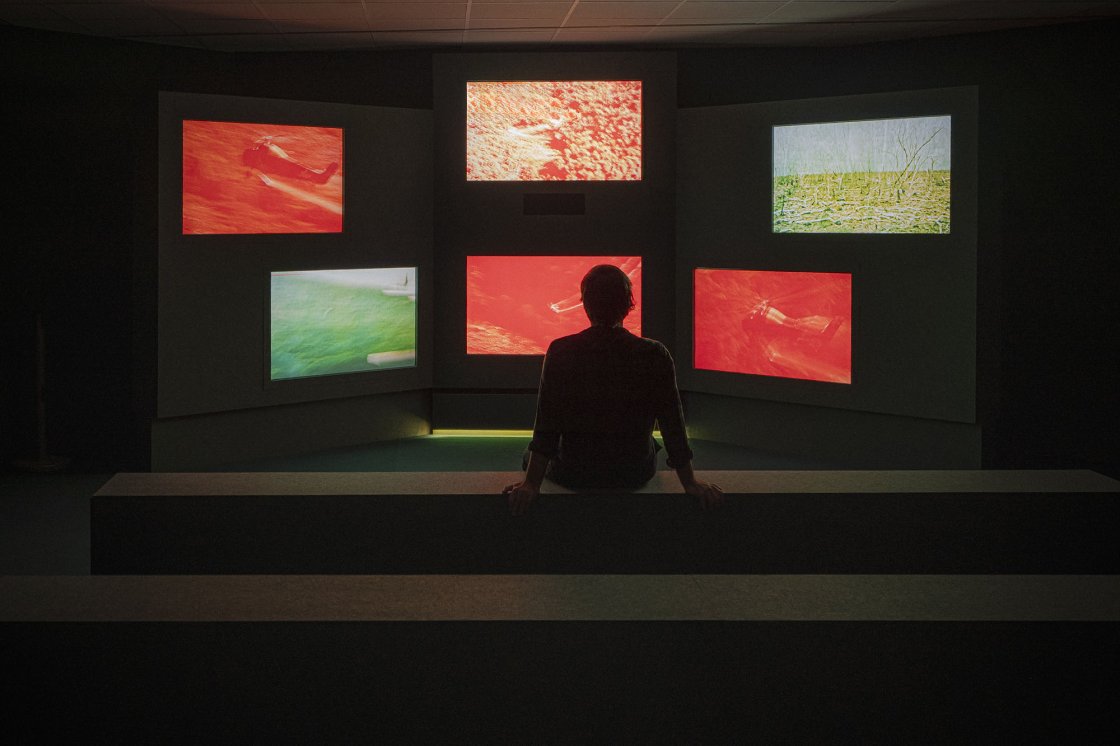
Timeline
The following timeline is indicative of some of the multiple geopolitical narratives that inform Listening All Night To The Rain through the layering of a vast assemblage of archival material, as well as to the global socio-political and cultural shifts that have shaped John Akomfrah’s artistic practice more broadly.
They indicate various markers in time that point to patterns and cadences in history and the ways in which narratives from the Global South have influenced one another. The lives and work of cultural and political figures are woven through stories of wars, migrations and seismic moments in the preservation of our natural world, acting as ghosts or spectres of the past that materialise in our present.
1910s
1914
Jamaican Marcus Garvey founded the Universal Negro Improvement Association (UNIA): the first mass movement of its kind to advocate for the empowerment and unity of people of African descent on a global scale.
1922
Mahatma Gandhi, the leader of India’s independence movement, was imprisoned for six years for his involvement in the Non-Cooperation Movement, which aimed to resist British rule through nonviolent means such as boycotts, strikes and protests.
1940s
1945
The Fifth-Pan African Congress was held in Manchester, UK and was attended by leading anti-colonial activists from Africa and the Caribbean including: Kwame Nkrumah who became the first President of a liberated Ghana, Jomo Kenyatta of Kenya, Jamaican Amy Ashwood Garvey (first wife of Marcus Garvey) and American sociologist W.E.B. Du Bois who was hailed as ‘the Father of Pan-Africanism’. Decisions made at this conference were instrumental in the success of multiple liberation struggles across Africa and the Americas.
1947
The partition of the British Raj into two separate nations of India and Pakistan was primarily based on religious groupings and enforced by the British parliament, leading to mass displacement, extreme violence and loss of life
1947-2017
A sequence of economic development plans, known as the ‘Five Year Plan’, was implemented by Jawaharlal Nehru after India’s independence following the depletion of resources by western occupation forces.
1948
The ship known as HMT Empire Windrush arrived in the UK marking the first significant mass migration of West Indian peoples to the UK to help with the post-war reconstruction of the country, subsequently forming the diasporic group known as the ‘Windrush Generation’.
1948-1994
The South African apartheid, a system of institutionalised racial segregation, was enforced by the National Party: a white supremacist political group primarily led by Dutch-descended Afrikaaners.
1950s
1950-60s
Caribbean sound system culture arrived in the UK during the post-war migration from the Commonwealth. Filling the void left by mainstream media’s neglect of black culture, particularly radio, the rise of sound systems became a symbol of resistance and cultural pride by diasporic communities.
1950-53
The Korean War was a US-backed conflict between North and South Korea that culminated in the division of the Korean Peninsula. The US military sprayed thousands of tonnes of hazardous DDT pesticide on Korean soil.
1952-60
The Mau Mau Uprising was an armed anti-colonial movement against British rule in Kenya, led primarily by the Kikuyu people. The brutal British counterinsurgency campaign employed collective punishment and executions.
1954-68
The US Civil Rights Movement was a social movement and campaign to abolish legalised racial segregation, discrimination and disenfranchisement. The movement sought to achieve full citizenship rights for Black Americans and other marginalised communities.
1955-75
A deadly conflict in Cambodia, Laos and Vietnam, as well as proxy war between the US and the Soviet Union, the Vietnam War is one of the most commonly referred to examples of ecocide due to the US Air Force spraying over 75 million litres of toxic herbicides over the region.
1956
The Suez Crisis was a diplomatic and military conflict between Egypt on one side and Britain, France and Israel on the other. It erupted when Egypt’s President Gamal Abdel Nasser nationalised the Suez Canal, prompting a military intervention by the Western powers to regain control in an attempt to maintain colonial influence.
1957
Led by Kwame Nkrumah, Ghana became the first sub-Saharan African nation to gain independence from British colonial rule, inspiring liberation movements across the continent. Nkrumah served as an inspiration to Martin Luther King Jr., who often looked to his leadership as an example of nonviolent activism.
1960s
1960
Stuart Hall, became the editor of the New Left Review in London and published pioneering studies on the role of film, television and mass media in determining cultural identity.
1960
Patrice Lumumba, a leading figure in the fight for Congolese independence, assumed office as the inaugural Prime Minister of Congo, marking the country’s liberation from Belgian occupation.
1962
The Sino-Indian War, also known as the China-India war, was an armed conflict contesting bordered territories between the two nations, notably the McMahon line: a borderline established by the British between Tibet and India.
1962
Rachel Carson’s groundbreaking book Silent Spring was published, exposing the dangers of pesticides and setting the stage for the modern environmental movement.
1963
The Republic of Kenya was established on 12 December led by the first Prime Minister: anti-colonial activist Jomo Kenyatta.
1964
American Muslim civil rights activist Malcolm X visited occupied Gaza, Palestine and was deeply impacted by the displacement and suffering caused by the 1948 Nakba. He declared, “Our problem in America is a problem that is worldwide”, drawing parallels between the Palestinian struggle and those of Black Americans.
1965
Shortly after Congo’s independence, a series of secessionist movements led to the assassination of Patrice Lumumba, and a coup d’etat by the autocratic leader Mobutu Sese Seko who changed Congo’s name to Zaire in 1971.
1965-75
The Black Arts Movement in the US, led by poet Amiri Baraka, celebrated black culture in the face of systemic racism and oppression. John Coltrane’s jazz album A Love Supreme was central to the movement, going on to inspire various resistance movements around the world, notably in apartheid South Africa where jazz was highly censored
1960s-1970s
1966
The Black Panther Party was founded by Bobby Seale and Huey P. Newton in the US. Advocating for black rights, socialism and armed self-defence, particularly against police brutality and systemic discrimination, there were multiple international chapters including in the UK and Algeria.
1966
After leading Ghana to independence, Kwame Nkrumah was overthrown due to his increasingly authoritarian rule by the National Liberation Council in a violent coup d’état.
1966-70
The Nigerian Civil War, or the Biafra War, was primarily driven by ethnic tensions with the Igbo (Biafra) ethnic group following the colonial amalgamation of land in 1914. Concurrent to the Vietnam War, this was one of the first wars in human history to be televised to a global audience.
1968
Martin Luther King Jr. was assassinated due to his prominent role in advocating for civil rights and racial equality in the US.
1968
The Women’s Liberation Movement (WLM) in the UK, spurred by events in the US, was formed to combat institutional sexism and fight for equal pay. Two important events this year organised by women workers galvanised the country: the Dagenham Ford Plant Strike by machinists and a campaign in Hull over local fishermen’s safety.
1969
David Oluwale, a Nigerian immigrant to Leeds, drowned in the River Aire after sustained harassment and abuse by police officers, leading to a landmark legal case of institutional racism in the UK.
1971
The self-determination movement in East Pakistan resulted in the formation of the nation state of Bangladesh, separating it from West Pakistan. This resulted in a bloody civil war and a humanitarian crisis of ten million displaced people.
1980s
1981
Riots erupted across England due to the ongoing discriminatory violence inflicted on black people by the police. The April Brixton riots in London were followed by protests in Liverpool, Birmingham, Leeds and Manchester.
1982-98
In response to the growing civil unrest and socioeconomic inequalities in Thatcherite Britain, the Black Audio Film Collective was formed and backed by a concerted effort from Channel Four Television and local councils to amplify black representation in the arts.
Década de 1990
1990s
The Kogi, an indigenous group in Colombia, warned the world of the first signs of environmental collapse in the BBC documentary From the Heart of the World.
1990
‘Poetics of Relation’, by Édouard Glissant is published. Reacting against the exclusion of black people from the cultural domain, Glissant challenges rigid notions of identity within Caribbean culture, promoting hybridity and the shared experience of postcolonial identities through poetic sensibilities.
1994
Nelson Mandela became the first Prime Minister of South Africa and the first democratic elections in the country were held.
2010s
2018
‘The Windrush scandal’ exposed the British government for wrongfully detaining, denying legal rights and deporting migrants from the UK to the Caribbean.
